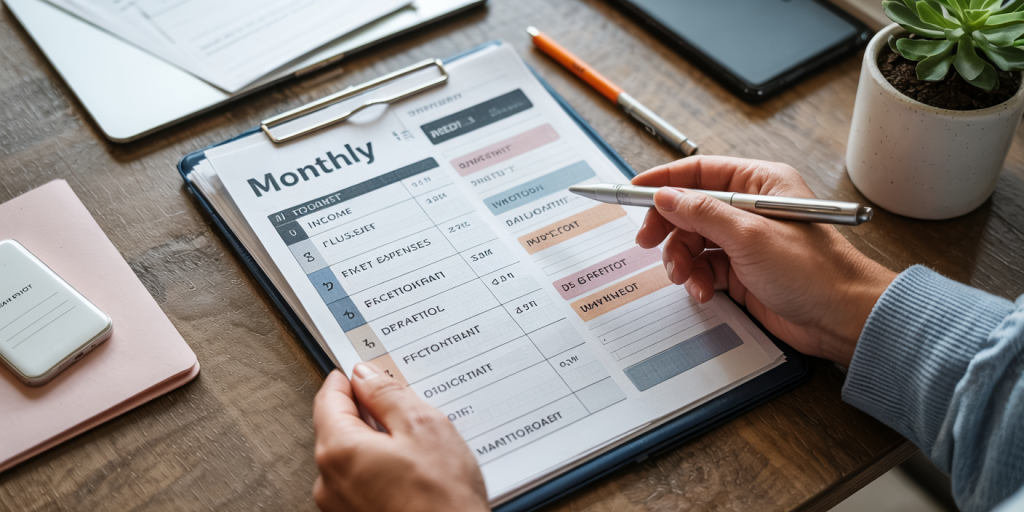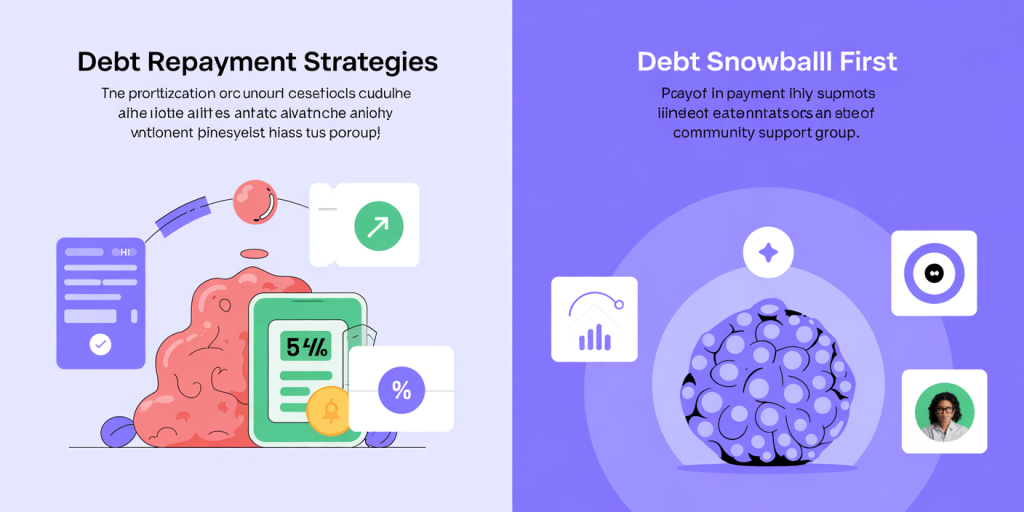How to Deal with Debt Without Panic: A 3-Step Plan A Direct and Functional Method to Get Out of the Red
Anúncios
Debt can feel like a relentless weight, causing anxiety, sleepless nights, and uncertainty about the future. Whether it’s credit card debt, student loans, or unexpected medical bills, thousands of people worldwide grapple with financial burdens daily. According to a 2023 report by the Federal Reserve, American consumer debt reached $16.7 trillion, illustrating how common debt issues truly are. Yet, panic rarely leads to a solution. With calm assessment and a strategic approach, you can regain control of your finances and steadily work your way out of debt. This article offers a practical 3-step plan focused on assessment, budgeting, and repayment strategies to help you navigate debt without panic effectively.

Understanding Your Debt Situation Clearly
Anúncios
The first and most crucial step in overcoming debt is to gain a clear and comprehensive understanding of your financial obligations. Panic often arises from uncertainty or a lack of knowledge about the total amount owed or the terms attached to each debt. Take the time to collect all your bills, statements, and loan documents to create a detailed list of your debts.
A practical example involves Lisa, a 35-year-old teacher with multiple credit cards, a car loan, and student debt. By writing down each debt amount, interest rate, minimum monthly payment, and due date, Lisa was able to visualize her total debt load of $48,000. This clarity helped her stop feeling overwhelmed and empowered her to start making informed decisions.
Often, people only focus on the total amount owed, but key factors such as interest rates and payment timelines provide critical insight into which debts are costing more and require immediate attention. Comparative analysis can be extremely beneficial here. The table below shows how interest rates and minimum payments differentiate the urgency and cost of various debts.
| Debt Type | Total Amount Owed | Interest Rate (%) | Minimum Monthly Payment | Estimated Months to Pay Off (Assuming No Additional Charges) |
|---|---|---|---|---|
| Credit Card A | $8,000 | 18.5 | $240 | 60 |
| Car Loan | $15,000 | 5.2 | $350 | 48 |
| Student Loan | $25,000 | 4.5 | $260 | 96 |
| Medical Bills | $3,000 | 0 (negotiable) | Varies | 12-24 |
By analyzing this table, it’s clear that the credit card debt carries the highest interest and will accumulate more cost over time if only minimal payments are made. In Lisa’s case, prioritizing high-interest debt made financial sense, even as she maintained payments on other obligations.
Step 1: Creating a Realistic and Flexible Budget
After understanding your debt landscape, the next step is to develop a functional budget that can sustain your living expenses while enabling increased debt repayment. Creating a budget is not about deprivation but about resource allocation to maximize financial health.
Start by tracking all sources of income and fixed expenses like rent, utilities, and insurance. Then, quantify variable expenses—groceries, transportation, entertainment—to identify opportunities for cost-cutting. Research from the National Endowment for Financial Education suggests that nearly 60% of personal bankruptcies in the U.S. are linked to medical expenses and unmanageable debt, often exacerbated by poor budgeting.
Revisiting the example of Lisa, she allocated $1,800 monthly to fixed expenses and found she spent around $600 on variable costs. By cutting down on non-essential expenses like dining out and subscription services, she reclaimed $200 each month, increasing her ability to repay debt without affecting her quality of life dramatically.
Many budgeting experts recommend using the 50/30/20 rule as a guideline—50% of net income to necessities, 30% to discretionary spending, and 20% toward savings and debt repayment. However, when debt is pressing, adjusting this distribution to increase the debt repayment portion can be necessary. Here’s a comparative overview of budget allocation in normal vs. debt repayment-focused scenarios:
| Budget Category | Typical Allocation (%) | Allocation During Debt Repayment (%) |
|---|---|---|
| Necessities | 50 | 50 |
| Discretionary | 30 | 15 |
| Savings & Debt Pay | 20 | 35 |
Importantly, any budget should be flexible and revisited monthly. Life changes, such as job promotions or new expenses, will require adjustments. The key is consistency and realistic goal-setting to sustain motivation without feeling overwhelmed.

Step 2: Choosing the Right Debt Repayment Strategy
Not all debts are equal, and one size does not fit all when it comes to repayment. Selecting the right strategy depends on your psychological preferences and financial situation. Two well-known methods are the Avalanche and Snowball methods. Debt Avalanche: Focus on paying off debts with the highest interest rates first, minimizing total interest paid over time. Debt Snowball: Pay off the smallest debts first, building momentum with quicker victories.
Continuing with Lisa’s case, she initially preferred the snowball method because paying off smaller debts gave her a motivational boost. Her first target was the $3,000 medical bill, which she cleared in 8 months by allocating extra payments from her budget. Afterward, she tackled her credit card debts aggressively with the avalanche method, saving nearly $2,500 in interest over time.
The following table illustrates how these strategies differ over a hypothetical debt portfolio:
| Strategy | Total Interest Paid* | Months to Complete Payoff | Psychological Impact |
|---|---|---|---|
| Debt Avalanche | $4,200 | 36 | Prioritizes cost-saving |
| Debt Snowball | $5,100 | 34 | Boosts motivation through wins |
*Note: Estimates based on average interest rates and balances.
Beyond these, negotiating with creditors for lower interest rates or payment plans can be a practical third approach. According to a 2022 survey by the Consumer Financial Protection Bureau, 73% of consumers who contacted creditors reported successful negotiation of better conditions. This is particularly useful with medical bills or credit cards.
Step 3: Implementing Behavioral and Support Mechanisms
Debt management is not purely arithmetic—it heavily involves emotional and behavioral dimensions. Stress and panic can lead to avoidance or poor financial decisions. Establishing behavioral practices and support systems significantly enhances the likelihood of success.
Automating payments is one practical tactic. For example, setting up automatic transfers to creditors reduces the chance of late fees and removes the temptation to spend the money allocated for debt repayment. A study published in the Journal of Financial Therapy (2021) found that automation increased on-time debt payments by 40%, easing mental burden.
Seeking emotional and professional support is equally important. Engaging a financial coach, joining peer support groups, or using apps designed to track and motivate debt repayment can help maintain momentum. Take the story of Ahmed, who, overwhelmed by $30,000 in diversified debts, joined an online community where members exchange tips and celebrate progress. This support network helped him reduce his debt by 25% in a year, highlighting how communal encouragement drives individual discipline.
Self-care activities, such as mindfulness and stress management, further reduce the anxiety associated with debt. Consistent anxiety can impair decision-making and lead to impulsive spending, counteracting your efforts. Thus, integrating debt repayment with overall wellness fosters a stable mindset for long-term success.
Looking Ahead: Building Financial Resilience Post-Debt
Once out of the red, the journey towards financial empowerment truly begins. A crucial future perspective is building resilience to avoid falling back into debt. This includes creating an emergency fund, improving financial literacy, and establishing solid saving and investing habits.

Data from the OECD indicates that roughly 30% of households globally lack sufficient savings to cover three months of expenses. An emergency fund acts as a financial buffer, preventing unexpected costs from triggering new debt. Starting small—such as saving $500—can provide significant psychological and practical benefits.
Continuous education is equally important. Understanding credit scores, investment basics, and future financial planning helps prevent cyclical debt. Many recent debt graduates use digital platforms like Coursera and Khan Academy for free financial courses or hire financial advisors for personalized plans.
Moreover, integrating automated savings and investment plans helps grow wealth steadily. For example, after clearing her debts, Lisa started allocating 15% of her income toward retirement and education funds, offering peace of mind for her future and that of her family.
In conclusion, dealing with debt without panic requires a blend of clear assessment, disciplined budgeting, strategic repayment, and emotional support. By following such a direct and functional 3-step plan, individuals can transform debt from a source of fear to a manageable challenge and ultimately reach financial stability and growth. With commitment and practical action, reclaiming control over personal finances is entirely achievable.
